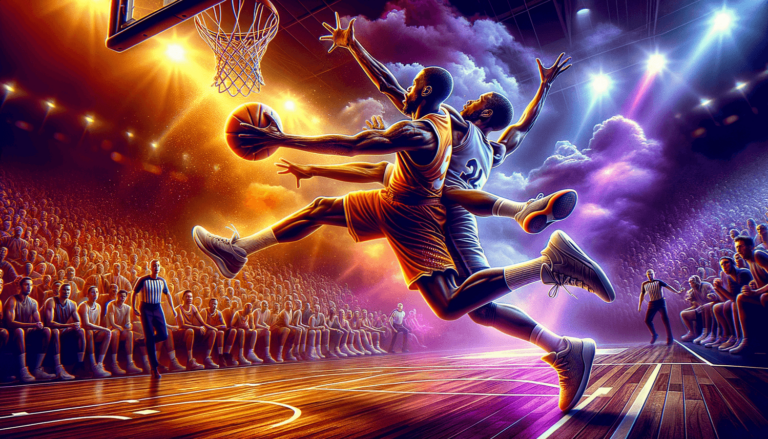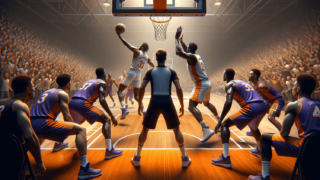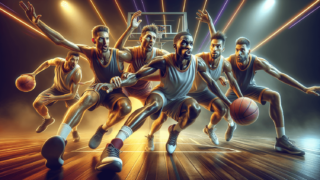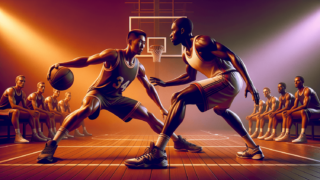
Basketball’s Unsportsmanlike Foul Rule: What’s Allowed and What’s Not
Written by: Basketball Universe
Last updated:

Welcome to the fascinating and sometimes controversial world of basketball’s unsportsmanlike foul rule! In a game where physicality and finesse collide, it’s important to understand the boundaries set by the rules to ensure fair play and sportsmanship. Strap yourselves in, dear readers, as we break down the ins and outs of what’s allowed and what’s not when it comes to unsportsmanlike fouls. With a fun and professional approach, we’ll navigate the intricacies of this rule, and by the time we’re done, you’ll have a solid grasp on the workings of one of basketball’s most debated topics. Let’s dive in!
Basketball’s Unsportsmanlike Foul Rule: What’s Allowed and What’s Not
In basketball, unsportsmanlike fouls are called to penalize behavior that goes against the spirit of fair play and sportsmanship. Some examples of unsportsmanlike fouls include excessive physical contact, flagrant fouls, taunting opponents, and intentional fouls with no legitimate attempt to play the ball. The punishment for unsportsmanlike fouls varies depending on the nature of the infraction, but can include free throws for the opposing team, ejection of the player who committed the foul, and even suspensions and fines for more severe offenses.
Understanding Basketball’s Unsportsmanlike Foul Rule
At the heart of any basketball game lies the delicate balance between fair competition and spirited, intense play. To maintain this balance, basketball rules have been put in place to define what’s allowed and what’s not. In this post, we’ll delve into the intricacies of the unsportsmanlike foul rule and examine various scenarios to help you grasp the complexities of this often contested aspect of the game.
The Difference Between Common Fouls and Unsportsmanlike Fouls
Before diving into the realm of unsportsmanlike fouls, it’s essential to understand the distinction between common fouls and unsportsmanlike fouls. Common fouls are inevitable in basketball and occur during the natural course of play, such as when a player makes illegal contact with an opponent while attempting to block a shot, steal a pass, or create space for a rebound. On the other hand, unsportsmanlike fouls involve actions that intentionally violate the spirit of fair play and sportsmanship. This can include excessive physical contact, flagrant fouls, taunting, or intentionally fouling an opponent without a legitimate attempt to play the ball.
Flagrant Fouls: Playing Rough Beyond the Call of the Game
What Constitutes a Flagrant Foul?
A flagrant foul is a type of unsportsmanlike foul that is defined by its unnecessary and excessive contact. Such fouls can be categorized into two types: Flagrant 1 and Flagrant 2. A Flagrant 1 occurs when a player commits a foul with unnecessary contact, but it’s not deemed malicious or excessively rough. The player at the receiving end of the foul is awarded two free throws, and their team receives possession of the ball.
Escalating to a Flagrant 2 Foul
A Flagrant 2 foul, on the other hand, is characterized by unnecessary and excessive contact that is deemed malicious or excessively rough. Committing a Flagrant 2 foul results in the offender being ejected from the game, with the victim receiving two free throws and their team gaining possession of the ball. A player who accumulates multiple Flagrant 2 fouls during a season may also receive additional fines or suspensions.
Taunting and Trash Talking: When Words Cross the Line
Basketball and the Art of Psychological Warfare
While a certain level of trash talking and friendly banter are part of the competitive atmosphere in basketball, there is a line that can be crossed, leading to unsportsmanlike conduct. Players who engage in excessive, derogatory, or offensive language or gestures may receive technical fouls (see section on technical fouls). The spirit of the game dictates that players respect and treat their opponents with sportsmanship throughout the match.
Intentional Fouls: Strategy or Unsportsmanlike Behavior?
What is Intentional Foul?
An intentional foul involves making illegal contact with an opponent on purpose, generally to stop the clock or disrupt the opponent’s offensive possession. While this can be seen as a strategic move, there’s a point where it crosses into unsportsmanlike territory. An intentional foul becomes unsportsmanlike when there is little to no effort to play the ball or prevent the opponent from scoring in a legitimate way.
Foul or Unsportsmanlike?
To help determine whether an intentional foul is unsportsmanlike, referees consider several factors, such as the severity of the contact, the intent of the player, and the context of the game (e.g., time left on the clock and the score). If a player commits an unsportsmanlike intentional foul, the opposing team is awarded free throws, and the offending player may receive a technical foul or even be ejected from the game.
Technical Fouls: Diluting the Spirit of the Game
Actions That Trigger Technical Fouls
Technical fouls can be assessed against a player or a coach for violating basketball rules and exhibiting behavior that negatively impacts the spirit of the game. Some examples of technical fouls include:
- Arguing with, showing disrespect, or physically contacting a referee
- Demonstrating unsportsmanlike conduct, such as taunting or using offensive language
- Intentionally delaying the game
- Committing an illegal defense (e.g., a zone defense in some leagues)
Upon receiving a technical foul, the opposing team is awarded one free throw, and the player who received the foul is given a warning. If a player or coach accumulates multiple technical fouls during a game, they may be ejected or suspended.
Paying the Price: Consequences of Unsportsmanlike Fouls
Players who commit unsportsmanlike fouls face various consequences, depending on the severity of the infraction. While penalties for common fouls usually involve awarding free throws, unsportsmanlike fouls can carry more severe punishments. In addition to free throws and possible ejections, players may also be subjected to fines and suspensions, as dictated by the governing basketball organization.
Preventing Unsportsmanlike Fouls: A Shared Responsibility
Ultimately, promoting sportsmanship and preventing unsportsmanlike fouls is a responsibility shared by players, coaches, and referees alike. Players must respect the game and their opponents, coaches should instill a culture of fair play, and referees must enforce the rules and penalize unsportsmanlike behavior accordingly. By understanding the intricacies of the unsportsmanlike foul rule and fostering a culture of sportsmanship, the true spirit of competition can shine on the basketball court.
Referees’ Role in Mitigating Unsportsmanlike Fouls
Referees play a crucial role in ensuring that basketball games are not only fair but also enjoyable for participants and spectators alike. By actively monitoring the game and enforcing basketball rules, referees contribute to maintaining the integrity of the sport. They are responsible for identifying and penalizing unsportsmanlike fouls and managing the game according to the set guidelines. This section discusses how referees handle different unsportsmanlike fouls and support the values of sportsmanship and fair play.
Game Preparation and Player Management
Referees often conduct pre-game meetings with both teams to clarify the rules and expectations, setting a tone of sportsmanship from the very beginning. Throughout the game, they maintain open communication with players and coaches, addressing any concerns and keeping all parties informed on foul-related decisions. By establishing trust and promoting transparency, referees endeavor to prevent unsportsmanlike fouls and diffuse potential conflicts before they escalate.
Punishing Unsportsmanlike Fouls: A Step-By-Step Approach
When penalizing unsportsmanlike fouls, referees typically follow a step-by-step process that includes:
- Identifying the unsportsmanlike action and stopping play
- Communicating the nature of the unsportsmanlike foul to players, coaches, and the scorer’s table
- Assessing the appropriate penalty (e.g., awarding free throws, team possession, or ejection)
- Recording the foul in the official game log and informing both teams of the player’s foul count
- Restarting play according to the applicable basketball rules
Referees must carry out these steps with accuracy, consistency, and impartiality to maintain credibility and uphold the standards of sportsmanship and fair play in basketball.
Advice for Players: Keeping Unsportsmanlike Fouls in Check
While understanding the mechanics of unsportsmanlike fouls and the subsequent penalties is essential, it’s equally crucial for players to recognize their role in preventing such fouls in the first place. Here is some advice to help basketball players minimize unsportsmanlike fouls and embrace the spirit of sportsmanship on the court:
Embrace the Values of Fair Play and Respect
Remember that sportsmanship goes beyond simply adhering to basketball rules. Embrace values such as fair play, respect, and teamwork, and strive to represent these values both on and off the court. Treat opponents, teammates, coaches, and referees with respect, and prioritize the spirit of the game over individual gains or rivalries.
Manage Emotions and Stay Composed
Competitive sports can stir a range of emotions, but it’s essential for players to remain composed in moments of frustration, disappointment, or anger. By managing emotions effectively, players can prevent reactive unsportsmanlike behaviors such as retaliatory fouls, trash talking, or unsportsmanlike gestures. If you find yourself struggling with intense emotions, consider taking a brief break, focusing on your breathing, or speaking with a teammate or coach for support.
Learn from Mistakes and Consequences
Finally, if you do receive an unsportsmanlike foul or a penalty, recognize it as an opportunity to learn and grow. Reflect on the cause of the foul and consider ways to prevent similar incidents in the future. By learning from mistakes and embracing the spirit of continuous improvement, players can contribute to a positive atmosphere on the basketball court and promote the values of sportsmanship and fair play.
Frequently Asked Questions About Basketball’s Unsportsmanlike Foul Rule
As the unsportsmanlike foul rule is a complex and multifaceted aspect of basketball, it’s not surprising that many questions arise on this topic. In this section, we’ll address ten frequently asked questions related to the unsportsmanlike foul rule and provide concise answers to help further clarify the subject. Let’s dive into these common inquiries!
1. Can a player be ejected from the game for a single unsportsmanlike act?
Yes, a player can be ejected from the game for a single unsportsmanlike act if the referees deem the action malicious or excessively unsportsmanlike. This usually occurs in cases of flagrant fouls (Flagrant 2) or extreme unsportsmanlike conduct.
2. Can coaches receive unsportsmanlike fouls and penalties?
Yes, coaches can receive unsportsmanlike fouls, typically in the form of technical fouls. These can be assessed for acts such as arguing with referees, using offensive language, or violating other basketball rules. Multiple technical fouls can result in the coach’s ejection from the game.
3. How many free throws are awarded for unsportsmanlike fouls?
The number of free throws awarded for unsportsmanlike fouls depends on the nature of the foul. A Flagrant 1 foul grants the opponent two free throws, while a Flagrant 2 foul also grants two free throws. Technical fouls generally award one free throw to the opposing team.
4. How does a referee decide if a foul is unsportsmanlike or not?
Referees consider factors such as the player’s intent, the severity of contact, and the game’s context (e.g., time remaining and the score). The referees then use their experience and understanding of the rules to determine if the foul is unsportsmanlike or not.
5. Can a player be fined or suspended for unsportsmanlike fouls?
Yes, players can be fined or suspended for unsportsmanlike fouls, particularly if they have a history of committing such fouls or if the infraction is particularly severe. The governing basketball organization determines fines and suspensions on a case-by-case basis.
6. What is the “Hack-a-Shaq” tactic, and is it unsportsmanlike?
The “Hack-a-Shaq” tactic refers to intentionally fouling a poor free-throw shooter to disrupt the opponent’s offensive possession. While it may be considered unsportsmanlike by some, it is not inherently an unsportsmanlike or flagrant foul, as long as there is a legitimate attempt to play the ball.
7. Can unsportsmanlike fouls be reviewed or overturned?
Yes, some unsportsmanlike fouls, particularly flagrant fouls, can be reviewed using instant replay, depending on the basketball league and its rules. Referees may upgrade or downgrade the severity of the foul upon review, and in certain cases, even overturn their initial decision.
8. Can a player receive an unsportsmanlike foul for flopping or exaggerating contact?
While it varies by league, a player can receive a technical foul for flopping or intentionally trying to deceive referees by exaggerating contact. Consistent flopping can lead to fines and penalties from the governing basketball organization.
9. Can an unsportsmanlike foul be called after a game has ended?
In some cases, unsportsmanlike fouls can be called or assessed after a game has ended, particularly if the actions have a significant impact on the game or the players involved. However, this is relatively rare and typically requires review by the governing basketball organization.
10. How can players prevent the accumulation of unsportsmanlike fouls?
Players can prevent the accumulation of unsportsmanlike fouls by practicing good sportsmanship, respecting their opponents, managing their emotions, and adhering to basketball rules. Understanding the repercussions of such fouls and focusing on personal growth can also contribute to reducing unsportsmanlike fouls.
Featured Posts
- No pillar pages found.





